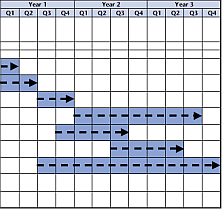Project Risk Management Template

- Risk Management: Overview
- What is Project Risk Management? Here’s a common definition of risk management: it’s a complex process for making decisions on accepting known or identified risks and implementing actions to mitigate negative consequences and decrease the probability of risk occurrence.
- Process. It’s a series of related activities and tasks to identify, analyze and control risks and their impact to a given project. The risk management process is one of the key processes within project management to detect any threats and uncertainties and produce a solution for responding to risks.
- Benefit. There are several core benefits from managing risks:
- Assessment of efficiency of the project management activities;
- Increased confidence in investments and strategic decisions;
- Responding to risks and uncertainties;
- Contingency planning;
- Records on the project risk management process can be used as lessoned learnt for future projects.
- Importance. It’s important to carry out the project risk management process because of the following:
- the probability of success gets higher;
- the decision making process becomes more efficient;
- contingency planning allows making the project viable and feasible.
- Best Practices. The successful practice of risk management in projects assumes three core steps:
- Analyzing Risks;
- Planning Responses;
- Controlling and Reporting Risks.
The given below project risk management checklist describes the steps in detail.
- Analyzing Project Risks.
- Definition. Project risk analysis is a systematic activity that assumes using all available information to determine how often a specified event may occur and what results it may bring. Risk analysis entails use of various approaches to describe and calculate risks and to assess undesired events and their causes and consequences to a project.
- Risk Identification. Identifying project risks is a process of determining and classifying any uncertainties and threats that may affect your project. The following classification of risks is given to demonstrate the groups of possible uncertainties and threats that may have an impact to your project:
- Strategic risks concern long-term strategic objectives and goals of the project. This type of project risks affects such areas of the project life-cycle as initial project planning, project financing, technological base, company reputation, stakeholder needs, changes in the physical environment, etc. Mitigation of strategic risks requires commitments of senior management to the strategic decision making and problem solving.
- Operational (tactical) risks concern uncertainties that have a shot-term impact on tactical objectives of your project within one operational period. Usually tactical risks affect daily operations and activities of the project team. Mitigation of such risks requires engagement of team leaders and project managers in making tactical decisions.
- Compliance risks concern challenges associated with the need to comply the project course with documented statements and regulations. Compliance risks refer to strategic characteristics of your project, such as stakeholder expectations, customer requirements, project baseline. Uncertainties about documentary compliance are managed to ensure current project activities are undertaken in the way it should be.
- Financial risks are associated with existing financial structure of the project and with all the transitions made to carry out project activities. Detection of financial risks involves examining financial operations and flows that ensure the fulfilment of project activities. Financial uncertainties are indications that denote to whether the project has serious implications for the viability.
- Knowledge risks are associated with effective exploitation and control of knowledge resources, technologies, management methods, communication mechanisms, and protection systems. Project knowledge uncertainties may include abuse of intellectual property, loss of key project staff, technological inefficiency, system malfunction.
- Risk Description. Describing project risks is a process of documenting characteristics and parameters of the risks identified. The process results in creating project risk descriptions and setting risk priorities which are used later for risk estimating. A risk description is a table which consists of the following columns:
- Name of risk
- Scope of risk – qualitative description of events that cause risk, their size, number and dependencies
- Nature of risk – identification of risk type according to the risk classification
- Expectations of stakeholders – statement of outcomes that stakeholders expect to achieve
- Risk treatment – a set of actions to control, monitor and report risk
- Responsible for risk strategy – a person or a group committed to treating and managing risks
- Risk Estimation. Estimating project risks is a process of determining factors that cause project risks in term of quantity and quality. There are two analyses conducted during the risk estimation process:
- Qualitative analysis allows defining reasons that create project risks in the context of qualitative characteristic of the project. Qualitative analysis is conducted by means of checklists, questionnaires, interviews and brainstorming sessions. During the analysis risk assessment forms, risk register and project scope statement are used to determine impacts of each risk and measure the likelihood of risk occurrence.
- Quantitative analysis often involves activities to measure uncertainties associated with the project schedule and budget. The analysis is focused on estimating deadlines, durations, and cost of project tasks. Quantitative analysis uses the risk register, cost management plan and schedule management plan to estimate tasks.
- Planning Responses
- Risk Management Plan. The core idea of the plan is to help the team produce better results in terms of time, cost, scope and quality. The plan is designed to ensure that:
- All threats and uncertainties are identified with reference to potential consequences they produce and the likelihood of occurrence.
- Individual risks related to planning and allocation of project resources are assessed and understood.
- Project risk management tools and techniques are planned and implemented to address all the existing opportunities for successful risk mitigation and responding.
- Cost-effectiveness is taken into account while planning for risk responses.
- Response Strategies. The process of managing risks can be handled through following a certain strategy. There’re four basic types of strategies for risk responding, such as shown below:
- Risk Avoidance Strategy. This strategy is also known as Risk Removal and Risk Prevention. The strategy allows altering a project risk management plan template so that the circumstances which may cause a risk no longer exist.
- Risk Mitigation Strategy. It’s also known as Risk Reduction Strategy and targeted at reducing the probability and impact of project risks.
- Risk Transference Strategy. It focuses on developing a plan for moving the impact of project risks to a third party.
- Risk Deferral Strategy. It’s a set of risk management guidelines for deferring treatment actions to a date when the risks are less likely to occur.
- Project Risk Register.
- Definition. Project risk register is one of the major documents of the project risk management process that contains information on identified risks, threats and opportunities that may impact qualitative and quantitative characteristics of a project. Risk register is created during the identification of project risks and then used throughout the whole life cycle of the project to manage the identified risks and risk responses.
- Update. While planning for project risk management template strategies and developing risk response approaches, opportunities (any positive outcomes that may bring additional value to the project through achieving improvement) can be identified. The risk register should be updated once a new opportunity is identified.
- Controlling Risks
- Definition. The process of controlling and monitoring risks aims at providing assurance that appropriate procedures for managing risks are clearly understood and strictly followed. The process allows determining whether:
- Risk response strategies were successfully implemented ad met what was actually planned.
- All information on project risk management procedures was appropriate.
- Risk management knowledge was used to identify what lessons could be learnt for risk measurements and assessment for future projects.
- Goal. It’s the primary goal of the risk control process to facilitate better change management and continuous improvement. The goal is usually achieved through organizing risk audits, re-assessment, technical performance measurements, reserve analysis, status meetings.
- Report. A project risk management template report is a summary of risks and opportunism, the status of responding procedures, and an indication of trends in the scope of risks. It’s an outcome of the risk control process that represents:
- Work performance data
- Project schedule progress
- Status of produced project deliverables














